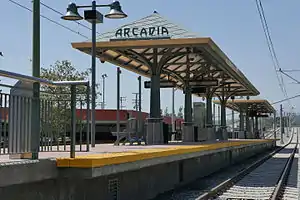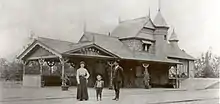Arcadia station
Arcadia station is an at-grade light rail station on the A Line of the Los Angeles Metro Rail system. It is located at the intersection of 1st Avenue and Santa Clara Street in Arcadia, California, after which the station is named.
Arcadia | |||||||||||||||||||||||
|---|---|---|---|---|---|---|---|---|---|---|---|---|---|---|---|---|---|---|---|---|---|---|---|
 Arcadia station platform | |||||||||||||||||||||||
| General information | |||||||||||||||||||||||
| Location | 73 East Santa Clara Street Arcadia, California | ||||||||||||||||||||||
| Coordinates | 34.1425°N 118.0288°W | ||||||||||||||||||||||
| Owned by | Los Angeles County Metropolitan Transportation Authority | ||||||||||||||||||||||
| Platforms | 1 island platform | ||||||||||||||||||||||
| Tracks | 2 | ||||||||||||||||||||||
| Connections | |||||||||||||||||||||||
| Construction | |||||||||||||||||||||||
| Structure type | At-grade | ||||||||||||||||||||||
| Parking | 300 spaces[1] | ||||||||||||||||||||||
| Bicycle facilities | Racks and lockers[2] | ||||||||||||||||||||||
| Accessible | Yes | ||||||||||||||||||||||
| History | |||||||||||||||||||||||
| Opened | 1887 | ||||||||||||||||||||||
| Closed | 1951 | ||||||||||||||||||||||
| Rebuilt | 2016[3] | ||||||||||||||||||||||
| Services | |||||||||||||||||||||||
| |||||||||||||||||||||||
| |||||||||||||||||||||||
| Location | |||||||||||||||||||||||
This station opened on March 5, 2016, as part of Phase 2A of the Gold Line Foothill Extension Project.[3][4] An overpass bridge was constructed over Santa Anita Avenue near the station.
History
Former bridge
In Arcadia, a steel railroad bridge transitioned the Atchison, Topeka and Santa Fe Railway between the I-210 and street grade. This bridge, between Baldwin and Santa Anita, was deemed unsafe following the 1994 Northridge earthquake and removed by Caltrans. The Phase 2A project constructed the "Iconic Freeway Structure or Gold Line Bridge" (IFS), as the replacement bridge. Designed by Minnesota artist Andrew Leicester, the bridge was unveiled in December 2012. Leicester's design was chosen from 17 others in a competitive process. The artist worked with L.A. design consultant AECOM as well as the bridge's builder, Skanska USA, on the final design and construction. The woven-basket look of the bridge's support columns emulate the woven baskets of the native Chumash people of the San Gabriel Valley while the underside of the bridge evokes a Western diamondback rattlesnake.[5][6]
Former service

Arcadia train station was added two years after the original the Los Angeles and San Gabriel Valley Railroad opened in 1885. The 1887 station was a Queen Anne-style passenger depot on First Avenue. The passenger station was decommissioned in 1951 and relocated in 1970 to the Fairplex, RailGiants Train Museum that is located inside the Los Angeles County Fairgrounds in Pomona.[7] The rail line was operated by the Atchison, Topeka and Santa Fe Railroad (Santa Fe), and served Amtrak's Southwest Chief and Desert Wind, although the latter never stopped at Arcadia. The Santa Fe line served the San Gabriel Valley until 1994, when the 1994 Northridge earthquake weakened the bridge in Arcadia. After the line was decommissioned in 1994, Arcadia became the destination for Metrolink's Rose Bowl train on New Year's Day. In 1996, a Sprinter was run from Arcadia to Monrovia. For an unknown period of time, the station was the home of a private railcar called the Pine Bluff until its purchase in the mid-2000s.
Arcadia train station should not be confused with the Lucky Baldwin's Santa Anita Depot that was a freight depot at Santa Anita Avenue and Colorado Boulevard and moved to the Los Angeles County Arboretum and Botanic Garden in 1970.
The station was formally dedicated in a ceremony held on August 22, 2015. Regular light rail service to the station began on March 5, 2016.[8]
Service
Station layout
| Westbound | ← |
| Island platform, doors will open on the left | |
| Eastbound | |
Hours and frequency
A Line trains run every day between approximately 4:30 a.m. and 11:30 p.m. Trains operate every 10 minutes during peak hours Monday through Friday, and every twelve minutes during the daytime on weekdays and all day on the weekends. Evening service (after 7 p.m.) is every 20 minutes.[9]
Connections
As of June 16, 2023, the following connections are available:[10]
- Arcadia Transit: Blue, Green, Red[11]
- Foothill Transit: 187, 270
- Los Angeles Metro Bus: 179, 287
References
- "Metro Parking Lots by Line". Los Angeles County Metropolitan Transportation Authority. Archived from the original on August 10, 2020. Retrieved November 5, 2021.
- "Secure Bike Parking on Metro" (PDF). Los Angeles County Metropolitan Transportation Authority. Archived from the original (PDF) on September 6, 2021. Retrieved November 5, 2021.
- Nelson, Laura J. (March 5, 2016). "Metro Gold Line extension tests San Gabriel Valley's support for transit". Los Angeles Times. Archived from the original on February 18, 2018. Retrieved March 6, 2016.
- Foothill Extension Archived April 28, 2010, at the Wayback Machine.
 Metro (LACMTA)
Metro (LACMTA) - David Ng (December 12, 2012), Artist to unveil Metro Gold Line bridge design in Arcadia Archived November 5, 2013, at the Wayback Machine Los Angeles Times.
- "Art of the Journey, The Foothill Gold Line" (PDF). Foothill Gold Line Construction Authority. Archived (PDF) from the original on August 24, 2016. Retrieved August 24, 2014.
- Santa Fe Station, Arcadia CA, circa 1887 Archived May 9, 2017, at the Wayback Machine. Railway & Locomotive Historical Society Southern California Chapter.
- "Arcadia Station dedicated on Foothills Gold Line". Trains Magazine. August 24, 2015. Archived from the original on August 25, 2015. Retrieved August 24, 2015.
- "Metro A Line schedule". Los Angeles County Metropolitan Transportation Authority. June 16, 2023. Retrieved June 12, 2023.
- "A Line Timetable – Connections section" (PDF). Los Angeles County Metropolitan Transportation Authority. June 16, 2023. p. 2. Retrieved June 17, 2023.
- "Arcadia Transit Fixed Route Services". City of Arcadia, California. August 13, 2018. Archived from the original on July 25, 2022. Retrieved May 14, 2022.